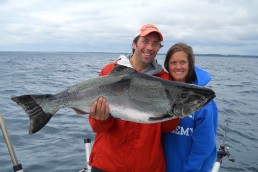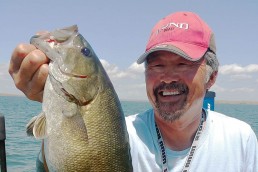Fall King Salmon | The Return of the King!
SHARE THIS POST
October is a special time of year for Great Lakes anglers, as four-year-old fall king salmon return from their deep-water haunts to rivers and harbors to spawn, and eventually die. During this time, they go through a transition, in which their silver color changes to dark brown. This is the one time of the year when anglers are able to cast lures on light tackle for big fall king salmon. Casting for fall king salmon is the best opportunity we Midwesterners have to catching a 15- to 25-pound fish, and the king salmon makes for a delicious dinner that is healthy as well!
A king’s life
Throughout its four-year life cycle, kings are fish-eating machines, stocked to control alewife populations in Lake Michigan. When they begin their migration from deep summer haunts to shallower water, trolling is the best option. Starting in September, however, you can cast for fall king salmon as they return to spawn inshore, following the dropping water temperature, to the place they were stocked or born.
Their bodies are at the end of their life cycle, and internal organs are shutting down, leaving only the primary mission–– spawning. Salmon will instinctively bite lure presentations. The return of fall king salmon typically begins in mid- to late September and goes throughout the month of October, depending on the different climates and location on the Lake.
Fall king salmon in the rivers
Early in the season, fishing the river mouths is the best place to start, as a majority of the fish are waiting at the mouth and are working towards making their run up the river. Females are looking for areas where they can deposit their eggs for fertilization, so look for rocky areas and spots without mud. Males will be adjacent to these areas––downstream, in deeper pockets, spillways, under bridges, and dams––awaiting the scent of deposited eggs. Inline spinners in bright colors like orange and red typically get fish to bite while fish are moving up the river and are getting ready to spawn. Catching fall king salmon after the spawn can be tricky, but can be done by fishing salmon spawn under a bobber, making repetitive casts over deep pockets to agitate fish into biting.
Fall king salmon in harbors
In other areas on Lake Michigan, where the creeks or not conducive for spawning, king salmon are stocked in harbors, which gives anglers the option to fish from shore or boat. Harbor fishing is accessible to most anglers and stocking locations can be found on the our website. In open water, kings will make big runs and fight without the worries of the obstructions that are in the rivers. Late night and early morning are the times when kings are most active. Earlier in the season, kings are still making the migration to shallow water, so start by fishing closer to the main lake and harbor mouths.
The use of vantage points is critical–– you will want to find areas where kings will be moving in from the main lake. Knowing these spots will help you to find fish concentrations. Later in the season, the fish move from harbor mouths to the inner harbors and swim along the rocks and walls looking for deep pockets and areas to spawn. The salmon are now locked inside the marinas until they die.
Are you enjoying this post?
You can be among the first to get the latest info on where to go, what to use and how to use it!
The right stuff
Spoons are the optimal choice when fall king salmon are holding in open water, and you need to cover as much water as possible with long casts. When fishing from a boat, make sure to use your graphs to locate the depth fish are holding at, then make long casts, counting down your bait to the desired depth and begin your retrieve.
For open water, deep-diving jerkbaits and casting spoons are the top choices in lure presentations for catching kings. The goal of these baits is to imitate alewives. Jerkbaits excel in triggering fish to bite in shallower water in the harbors. Work them in the same fashion you would use a crankbait––fish it over rocks, deep holes and parallel cast break-walls. The rattles in the jerkbait will bring in fish from a distance and provoke them into biting. Keep in mind that slow and steady retrieves will produce more fish than fast ones.
Some of the top choices in deep-diving jerkbaits are the Jackall Dowzvido, Lucky Craft Staysee 90 SP, and the Berkley Flicker Minnow. Fall king salmon have a tendency to destroy lures, which is why I opt to use the Jackall Dowzvido––it is built with stronger plastic that holds up to the rigors of salmon fishing, and has a loud rattle chamber, and has an erratic action that brings more bites than other jerkbaits. Most jerkbaits are made for bass fishing, and the hooks will bend out after the first king salmon, so be sure to switch out the stock hooks with extra strong treble hooks.
Having the right combo is essential when fishing for fall king salmon. Fall king salmon are at their maximum size and make ferocious runs. You need a rod that is able to make long casts, distribute pressure evenly, and have the power to turn the direction of a king if necessary. I recommend a G. Loomis E6X in the 8-foot, 6-inch medium power, fast action model. Implementing the correct reel is a necessity, and the Shimano Stradic FK in the 4000 size has a smooth, sturdy and reliable drag that will not burn out from a single night of aggressive salmon runs. My line is 20- pound PowerPro Maxcuatro with a 12-pound-test Seaguar AbrazX Leader. The braided line has more than enough strength to hold up to the weight of kings and the thinner diameter allows for longer casts. Give fall king salmon fishing a try!
IF you enjoyed this article, check out Bobby’s article on finesse swimbaits for smallmouth bass
MWO
SHARE THIS POST
Did you enjoy this post?
You can be among the first to get the latest info on where to go, what to use and how to use it!
Bobby Bergren
“Bobby B” Bergren is a smallmouth bass fishing fanatic who’s passion is fishing the Great Lakes. He has multiple first-place tournament wins on Lake Michigan. Additionally, he is a die-hard ice fishing enthusiast who targets bluegills, and dabbles in hunting and knife collecting. Bergren also engages in content creation and digital marketing for MidWest Outdoors.



